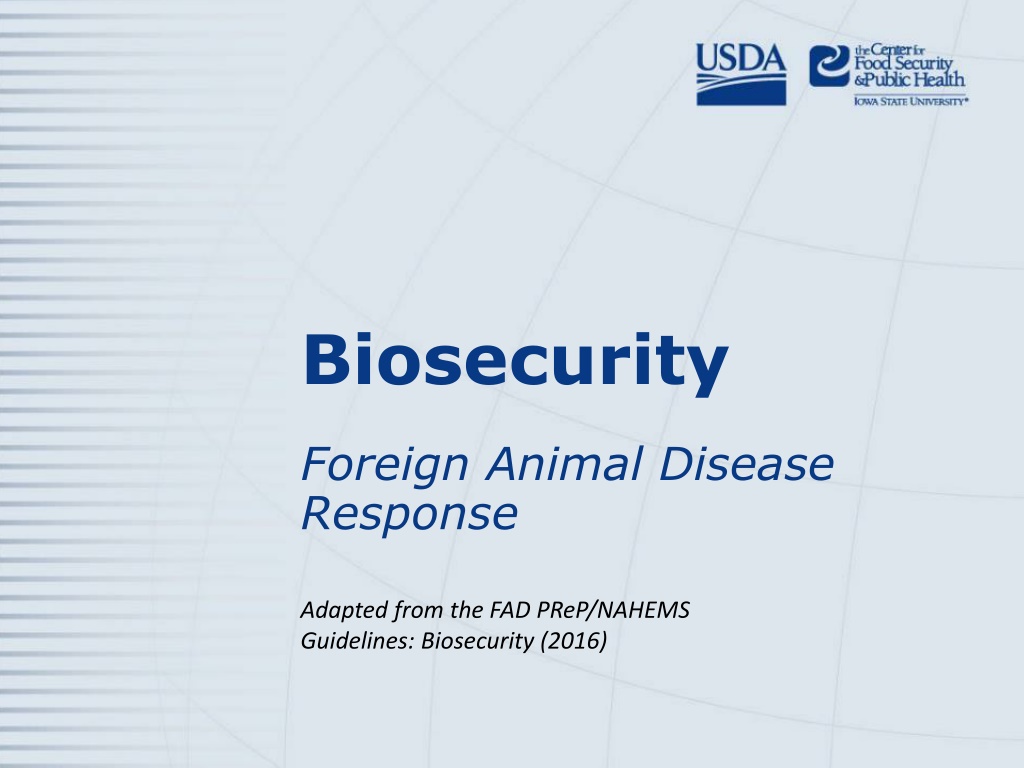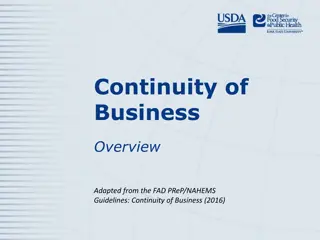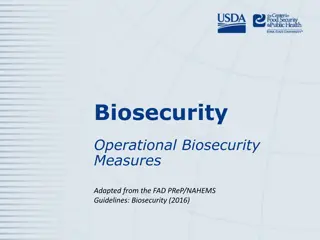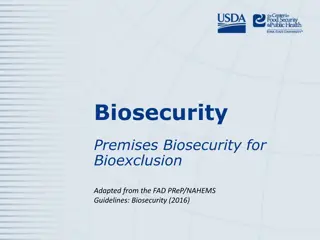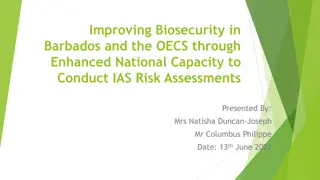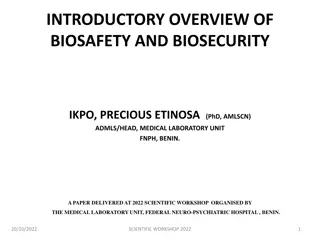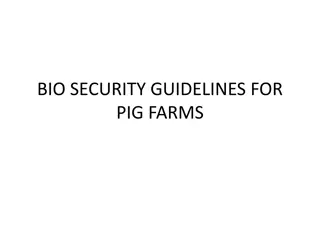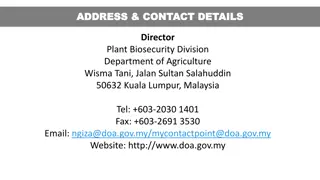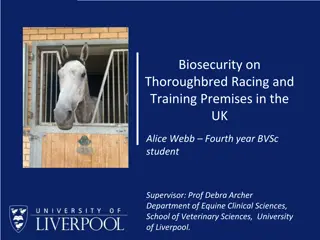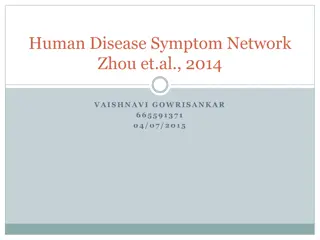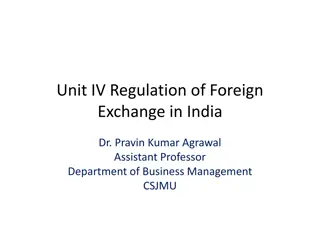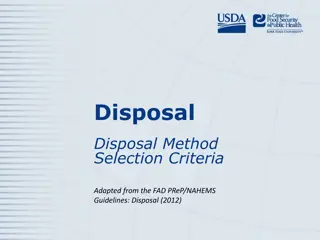Biosecurity in Foreign Animal Disease Response
This presentation highlights the key aspects of biosecurity in response to foreign animal diseases. It covers the goals of disease detection, containment, and eradication, emphasizing the importance of biocontainment and bioexclusion. The role of biosecurity in maintaining continuity of business, protecting public health, and facilitating normal production is emphasized. The activities involved in disease response, including contact with infected populations and premises, are discussed, along with the various protocols and considerations needed for effective biosecurity measures.
Download Presentation

Please find below an Image/Link to download the presentation.
The content on the website is provided AS IS for your information and personal use only. It may not be sold, licensed, or shared on other websites without obtaining consent from the author.If you encounter any issues during the download, it is possible that the publisher has removed the file from their server.
You are allowed to download the files provided on this website for personal or commercial use, subject to the condition that they are used lawfully. All files are the property of their respective owners.
The content on the website is provided AS IS for your information and personal use only. It may not be sold, licensed, or shared on other websites without obtaining consent from the author.
E N D
Presentation Transcript
Biosecurity Foreign Animal Disease Response Adapted from the FAD PReP/NAHEMS Guidelines: Biosecurity (2016)
This Presentation Zones, areas, and premises designations during an FAD response Roles and responsibilities Work Zones of a contaminated premises Concepts of biocontainment and bioexclusion FAD PReP/NAHEMS Guidelines: Biosecurity - Foreign Animal Disease Response USDA APHIS and CFSPH
FAD Response Goals 1. Detect, control, and contain the disease in animals as quickly as possible; 2. Eradicate the disease using strategies that seek to stabilize animal agriculture, the food supply, and the economy and that protect public health and the environment; and 3. Provide science- and risk-based approaches and systems to facilitate continuity of business for non-infected animals and non-contaminated animal products. FAD PReP/NAHEMS Guidelines: Biosecurity - Foreign Animal Disease Response USDA APHIS and CFSPH
FAD Response Goals, contd Achieving these three goals will allow individual livestock facilities, States, Tribes, regions, and industries to resume normal production as quickly as possible. They will also allow the United States to regain disease-free status without the response effort causing more disruption and damage than the disease outbreak itself. Biosecurity plays a vital role in each of the three goals. FAD PReP/NAHEMS Guidelines: Biosecurity - Foreign Animal Disease Response USDA APHIS and CFSPH
Importance of Biosecurity Biocontainment Contains FAD on an infected premises Facilitates eradication Bioexclusion Protects health of non-infected animals Allows continuity of business If zoonotic, protects public health FAD PReP/NAHEMS Guidelines: Biosecurity - Foreign Animal Disease Response USDA APHIS and CFSPH
FAD Response Activities Disease response requires contact with infected populations and contaminated premises Also involves non-infected animals and premises Clean or dirty side based on disease/health status of animals Line of Separation defended Protocols vary due to multiple factors Facility, disease status, pathogen, tasks FAD PReP/NAHEMS Guidelines: Biosecurity - Foreign Animal Disease Response USDA APHIS and CFSPH
Zones, Areas, Premises Designations in an FAD Outbreak FAD PReP/NAHEMS Guidelines: Biosecurity - Foreign Animal Disease Response USDA APHIS and CFSPH
Zones, Areas, and Premises FAD PReP/NAHEMS Guidelines: Biosecurity - Foreign Animal Disease Response USDA APHIS and CFSPH
Zones, Areas, and Premises FAD PReP/NAHEMS Guidelines: Biosecurity - Foreign Animal Disease Response USDA APHIS and CFSPH
Containment and/or Exclusion Premises designations Source of infection Enhanced risk of disease exposure Type of response activities Biocontainment and/or bioexclusion Business continuity Secure Food Supply Plans Secure Poultry Supply Plans: Eggs, Turkeys, Broilers Milk, Pork, and Beef plans FAD PReP/NAHEMS Guidelines: Biosecurity - Foreign Animal Disease Response USDA APHIS and CFSPH
Roles and Responsibilities during an FAD Response FAD PReP/NAHEMS Guidelines: Biosecurity - Foreign Animal Disease Response USDA APHIS and CFSPH
Incident Command System (ICS) Organizational structure Flexible and scalable Depends on size, scope, and nature of the incident Incident Management Team (IMT) Biosecurity conducted by Operations Section FAD PReP/NAHEMS Guidelines: Biosecurity - Foreign Animal Disease Response USDA APHIS and CFSPH
Foreign Animal Disease Diagnostician FADD implements biocontainment principles during the investigation Premises will be quarantined if an FAD is suspected Movement will be restricted FAD PReP/NAHEMS Guidelines: Biosecurity - Foreign Animal Disease Response USDA APHIS and CFSPH
Operations Section Assessment, design, and supervision Implementation on-site Animal Biosecurity Group Supervisor (or designee) Site assessment of each contaminated (dirty) premises Leads development of site-specific biosecurity plan Appropriate biocontainment measures Determines resource needs/training FAD PReP/NAHEMS Guidelines: Biosecurity - Foreign Animal Disease Response USDA APHIS and CFSPH
Operations Section contd Develops biosecurity plan for clean operations Appropriate bioexclusion measures to protect na ve populations Used by surveillance teams, etc. Coordinate with all other on-site activities: C&D, depopulation, and disposal Procedures must be followed by all FAD PReP/NAHEMS Guidelines: Biosecurity - Foreign Animal Disease Response USDA APHIS and CFSPH
Biosecurity Managers/Officers Appointed by Incident Command Reports to Biosecurity Group Supervisor Provides on-site management, coordination and gains compliance Reports needs, problems, and violations Halts biosecurity breaches Enforces compliance FAD PReP/NAHEMS Guidelines: Biosecurity - Foreign Animal Disease Response USDA APHIS and CFSPH
Biocontainment FAD PReP/NAHEMS Guidelines: Biosecurity - Foreign Animal Disease Response USDA APHIS and CFSPH
Work Zones Separation between dirty and clean Hot Zone-Exclusion Zone (EZ) Warm Zone-Contamination Reduction Zone (CRZ) Cold Zone-Support Zone (SZ) Access is controlled Decontamination Corridor FAD PReP/NAHEMS Guidelines: Biosecurity - Foreign Animal Disease Response USDA APHIS and CFSPH
Work Zones contd FAD PReP/NAHEMS Guidelines: Biosecurity - Foreign Animal Disease Response USDA APHIS and CFSPH
Decontamination Corridor FAD PReP/NAHEMS Guidelines: Biosecurity - Foreign Animal Disease Response USDA APHIS and CFSPH
Protocols for Biocontainment Prior to entering Hot Zone Identify Work Zones Vehicles remain in Cold Zone Don PPE Prepare to contain disposables Set up C&D supplies Take only necessary items Enter through proper access point FAD PReP/NAHEMS Guidelines: Biosecurity - Foreign Animal Disease Response USDA APHIS and CFSPH
Protocols for Biocontainment contd While in Hot Zone Minimize exposure to pathogen Restrict environmental contamination Limit equipment contamination Monitor compliance Maintain log and verify authorization Perform C&D duties in the Decon corridor FAD PReP/NAHEMS Guidelines: Biosecurity - Foreign Animal Disease Response USDA APHIS and CFSPH
Protocols for Biocontainment contd Upon leaving Hot Zone Exit only through Decon Corridor C&D all supplies, equipment Doff PPE Contain trash and disposables Cross Line of Separation Extra precaution: wash hands, disinfect vehicle tires and wheel wells Avoid contact with susceptible species FAD PReP/NAHEMS Guidelines: Biosecurity - Foreign Animal Disease Response USDA APHIS and CFSPH
Bioexclusion FAD PReP/NAHEMS Guidelines: Biosecurity - Foreign Animal Disease Response USDA APHIS and CFSPH
Protocols for Bioexclusion Line of Separation Animal side is considered clean Facility plan may have Perimeter Buffer Area and Line of Separation Comply with facility plan Encourage a facility escort FAD PReP/NAHEMS Guidelines: Biosecurity - Foreign Animal Disease Response USDA APHIS and CFSPH
Protocols for Bioexclusion contd Prior to entering facility Confirm/establish Line of Separation Disinfect all items Park vehicle outside biosecure area Leave all unnecessary items behind Don clean outwear and boots Prepare fresh C&D supplies Protect susceptible animal groups FAD PReP/NAHEMS Guidelines: Biosecurity - Foreign Animal Disease Response USDA APHIS and CFSPH
Protocols for Bioexclusion contd Exiting the Line of Separation: Follow the entry protocols in reverse C&D boots and equipment or contain for later cleaning or disposal Clean response vehicles Pay extra attention when collecting samples and/or visiting multiple premises FAD PReP/NAHEMS Guidelines: Biosecurity - Foreign Animal Disease Response USDA APHIS and CFSPH
Conclusion Maintains food safety and security Protects the environment Facilitates continuity of business Protocols are site/situation specific Need consistent compliance FAD PReP/NAHEMS Guidelines: Biosecurity - Foreign Animal Disease Response USDA APHIS and CFSPH
For More Information FAD PReP/NAHEMS Guidelines & SOP: Biosecurity (2016) http://www.aphis.usda.gov/fadprep Biosecurity web-based training module: http://naherc.sws.iastate.edu/ FAD PReP/NAHEMS Guidelines: Biosecurity - Foreign Animal Disease Response USDA APHIS and CFSPH
Guidelines Content Authors (CFSPH) Janice P. Mogan, DVM Heather Allen, PhD, MPA Kristen Bretz, MS Reviewers (USDA) Jonathan T. Zack, DVM James A. Roth, DVM, PhD, DACVM FAD PReP/NAHEMS Guidelines: Biosecurity - Foreign Animal Disease Response USDA APHIS and CFSPH
Acknowledgments Development of this presentation was by the Center for Food Security and Public Health at Iowa State University through funding from the USDA APHIS Veterinary Services PPT Authors: Janice P. Mogan, DVM; Logan Kilburn Reviewer: Kristen Bretz, MS
